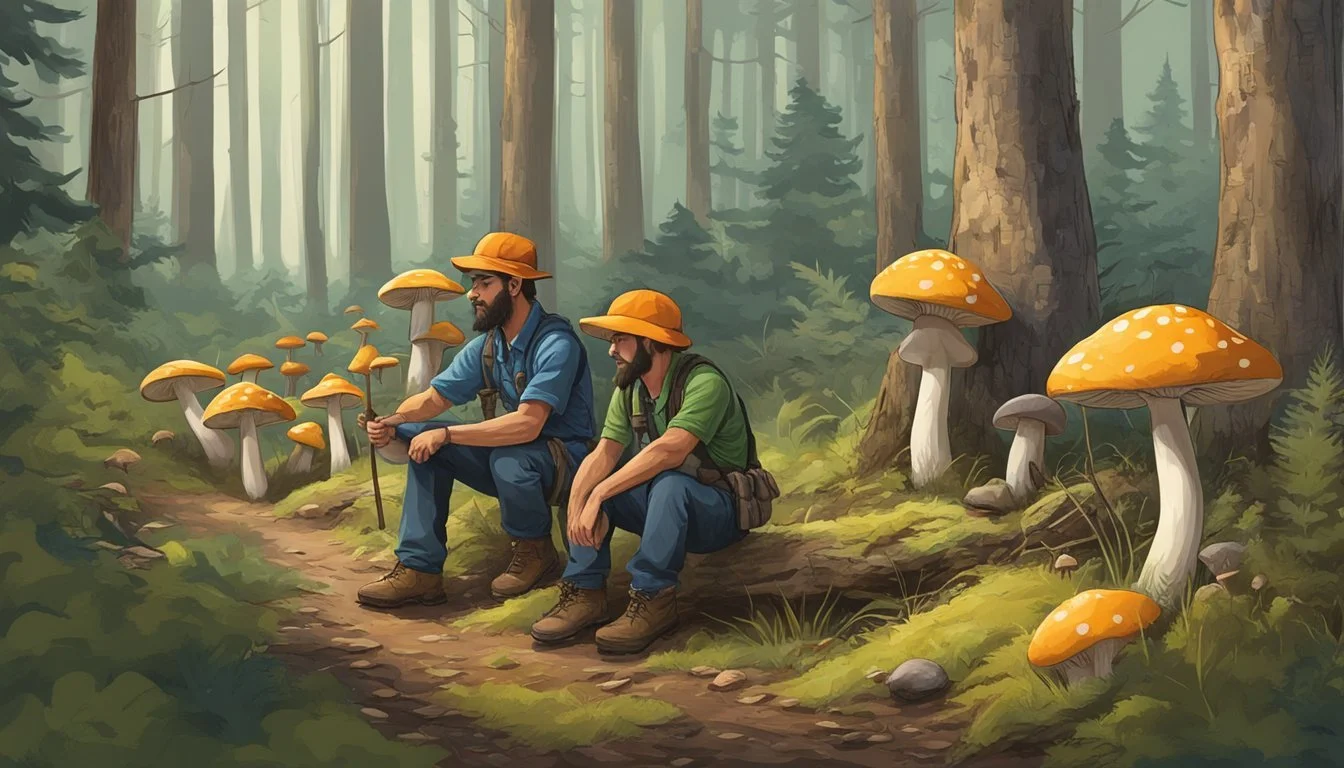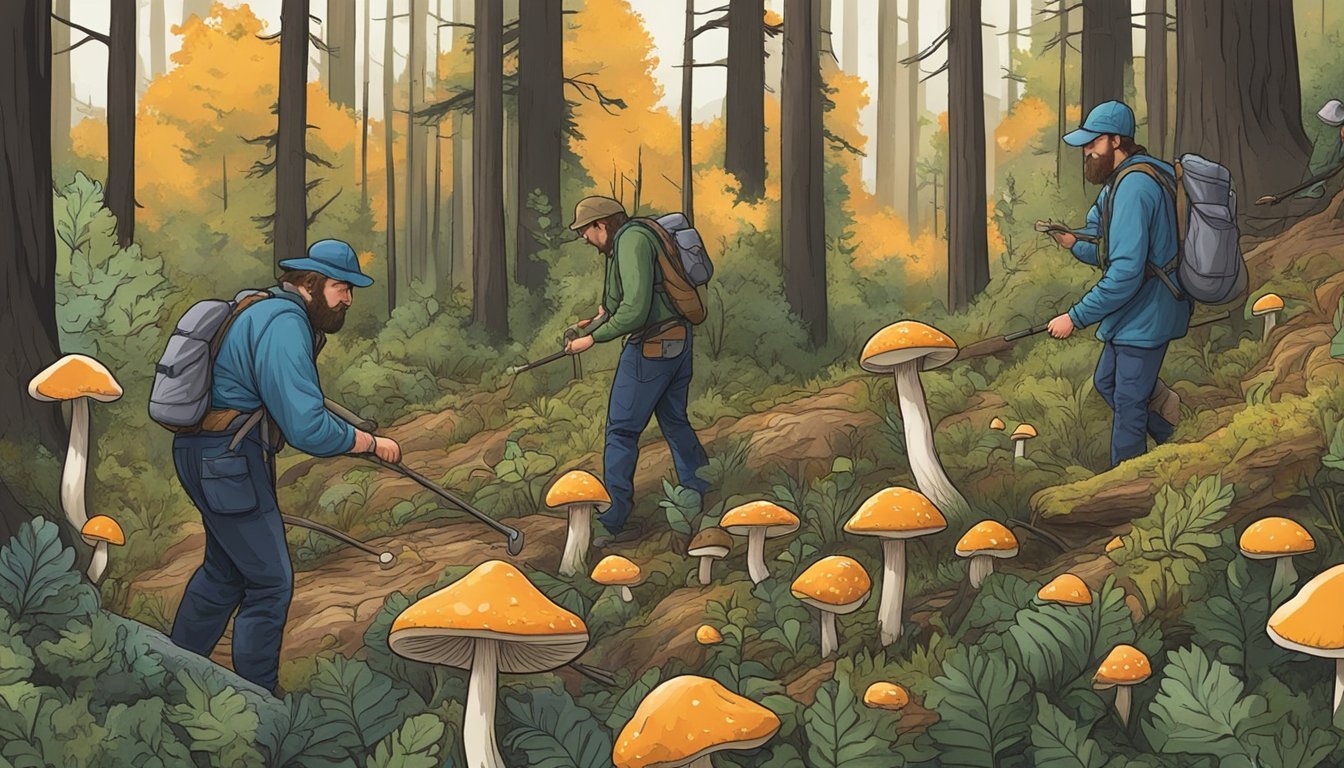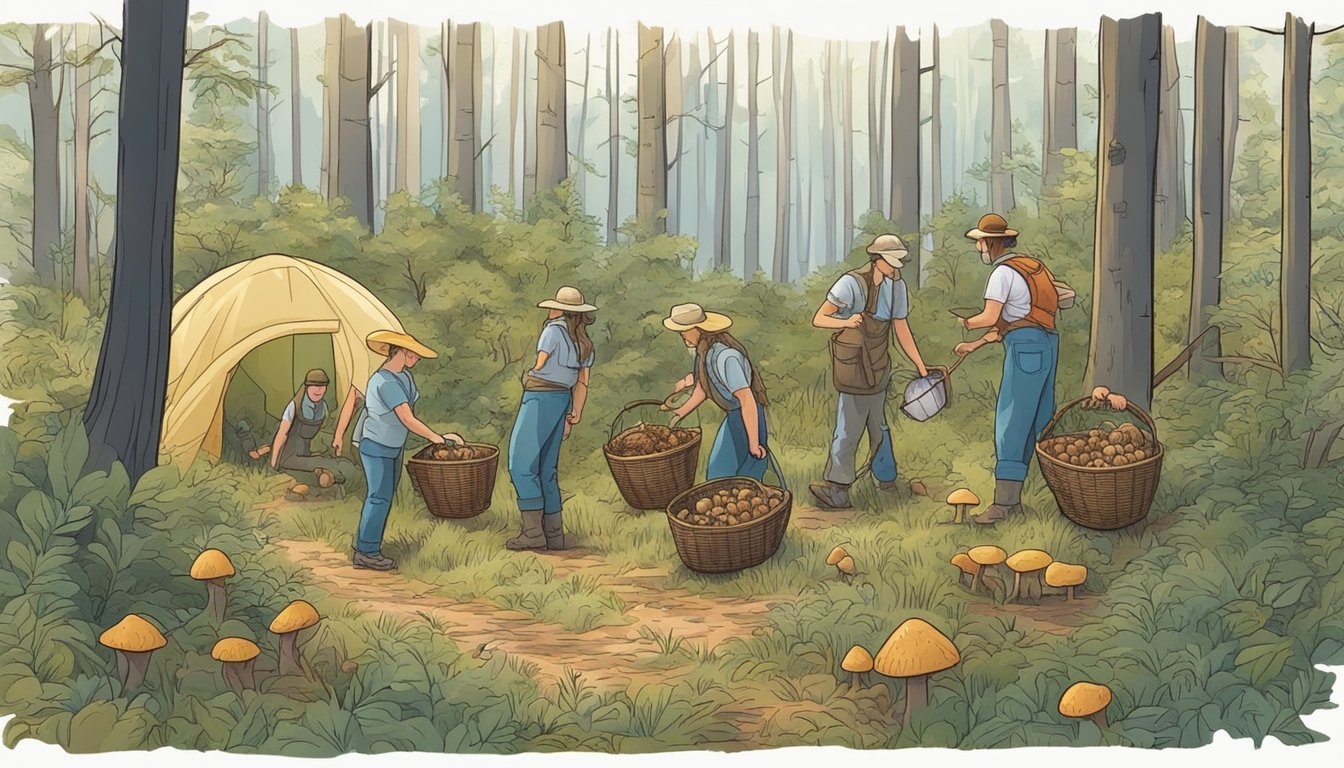Mushroom Hunting Oklahoma
A Guide to Safe Foraging Practices
This Article is Part of Our Guide on Mushroom Hunting for All 50 States
Mushroom hunting in Oklahoma offers a delightful experience for foragers, with the state's diverse landscapes providing fertile grounds for a variety of fungal treasures. One of the most coveted finds is the morel mushroom, known for its unique honeycomb appearance and savory flavor. The morel mushroom season, particularly prominent in the early weeks of April, beckons enthusiasts to the region’s forests. These fungi favor the humid and damp conditions prevalent in Oklahoma during spring, creating an ideal hunting ground for both novice and experienced mushroom gatherers.
Understanding the environment where mushrooms (What wine goes well with mushrooms?) thrive is key to a successful forage. Oklahoma's rich lands, nestled between the Rockies and the Ozarks, feature many dense forests with the necessary soil acidity, host trees, and other growth conditions specific to mushrooms like morels and chanterelles. Foragers should equip themselves with knowledge on mushroom species, local regulations, and ethical harvesting techniques, such as using a pocket knife to cut morels at the stem instead of plucking, to ensure sustainability and personal safety.
A foray into Oklahoma's woods for mushroom hunting is not only a chance to collect edible fungi but also an opportunity to connect with nature. The activity requires a keen eye and a bit of patience, but the reward of foraged delicacies is well worth the effort. As mushroom hunting grows in popularity, it is increasingly important to approach the practice with respect for the environment and local ecosystem to preserve the experience for future generations.
Foraging for More Than Just Mushrooms in Oklahoma
Oklahoma's prairies and woodlands are a hidden gem for foragers seeking more than just mushrooms. The state's diverse ecosystems offer a variety of wild edibles, from pecans and persimmons to wild onions and watercress. Uncover the flavors of the Sooner State as you explore its natural abundance through the art of foraging.
👉 Foraging for Wild Edibles in Oklahoma
Commonly Found Edible Mushrooms in Oklahoma
Oklahoma is home to several edible mushroom species. Some of the most commonly found edible mushrooms in the state include:
Morel (Morchella spp): Commonly found in Oklahoma, morel mushrooms have a distinctive honeycomb appearance and are prized for their rich, earthy flavor.
Chanterelle (Cantharellus spp): These golden to yellowish-orange mushrooms are often found in wooded areas in Oklahoma and have a delicate, fruity aroma and a mild, peppery taste.
Chicken of the Woods (Laetiporus spp): Often found on decaying hardwood trees in Oklahoma, these bright orange shelf-like mushrooms have a soft texture and a flavor reminiscent of chicken.
Hen of the Woods (Grifola frondosa): Also known as maitake, these large, frilly mushrooms grow at the base of oak trees in Oklahoma and have a rich, earthy flavor and a meaty texture.
Oyster Mushroom (Pleurotus spp): Commonly found growing on dead or dying hardwood trees in Oklahoma, oyster mushrooms have a delicate flavor and a velvety texture, making them a versatile culinary ingredient.
It is essential to properly identify any mushroom before consuming it, as some species can be poisonous. Beginners should go mushroom hunting with an experienced guide or join a local mycological society to learn how to identify edible mushrooms safely.
Understanding Mushrooms in Oklahoma
Oklahoma's diverse landscapes foster a rich variety of fungi, essential knowledge for enthusiasts seeking to forage mushrooms. Understanding the characteristics, lifecycle, and mushroom types, including edible and toxic varieties, is crucial for a safe and successful foraging experience.
Characteristics of Local Fungi
Mushrooms in Oklahoma exhibit diverse features that aid in identification. They possess a range of cap shapes, from the umbrella-like caps of morels to flat and broad ones seen in oyster mushrooms. The colors can vary from the golden hues of the Ringless Honey Mushroom to the stark white of Destroying Angels. Gills, which can be visible underneath the cap, may range from narrow to broad and from white to brownish in coloration.
Mushroom Lifecycle and Spores
Mushroom lifecycle starts with spore germination, leading to the development of a mycelial network, and eventually fruiting bodies, which are the mushrooms themselves. Spores are microscopic and vary in color; the spore print, a mushroom identification method, can reveal shades from white to dark brown. For instance, the Ringless Honey Mushroom produces white spores, which is a key identification feature.
Toxic and Poisonous Varieties
Among mushrooms found in Oklahoma, there are toxic and poisonous species that foragers must avoid. These include:
Destroying Angels (Amanita virosa): White and similar in appearance to edible species but highly poisonous.
False Morels (Gyromitra): Can be mistaken for true morels but contain harmful compounds.
Identifying characteristics of poisonous mushrooms often requires expert knowledge, and ingestion of toxic mushrooms can lead to severe illness or even death. It is essential that foragers ascertain the safety of mushrooms before consuming them.
Best Time for Mushroom Hunting
The peak time for mushroom foraging in Oklahoma aligns with specific seasonal patterns and favorable weather conditions, as mushrooms thrive in particular temperatures.
Seasonal Patterns
Mushrooms in Oklahoma have their growth cycles, with spring and fall being the most opportune times for hunters to find a variety of species. Morels, a sought-after variety, typically emerge in spring, marking the beginning of the mushroom hunting season. Other species, like the Puff Ball and Shaggy Mane, also appear during spring and then again in fall, offering a second harvest.
Weather Conditions and Temperature
The abundance of mushrooms is highly influenced by the weather conditions. Foragers should seek days that follow a wet period, as moisture promotes mushroom growth. Temperatures that are not too cold nor too hot, ideally ranging between 50-70 degrees Fahrenheit, set the perfect stage for mushroom hunting. Hunters should monitor local weather to determine the ideal times, as fluctuations are frequent and can impact fungal fruiting.
Preparing for a Mushroom Hunt
Before venturing into the woods of Oklahoma for mushroom hunting, it is crucial to equip oneself with the necessary gear, be aware of essential safety measures, and know how to accurately identify morel mushrooms to ensure a positive and safe foraging experience.
Essential Gear
A forager should have the following items to maximize the success and enjoyment of their hunt:
Mesh Bag or Basket: A mesh bag allows for the dispersion of mushroom spores, promoting future growth. Alternatively, a basket can be used to avoid crushing the mushrooms.
Clothing: Durable clothing suitable for the outdoors and variable weather conditions is necessary. One should also include:
Clothing Item Purpose Long Pants Protection from underbrush and ticks Boots Sturdy footwear for uneven and wet terrain Gloves Protection against thorns and poison ivy Hat Shielding from the sun or low-hanging branches
Safety Measures
For safety, hunters should be aware of the following:
Ticks can be a concern; hence, wearing long sleeves, using repellents, and conducting regular tick checks is essential.
Snakes may also be encountered; therefore, vigilance is recommended, especially in rocky areas or near logs.
Familiarize oneself with pictures of poison ivy to avoid contact, and stay on clear paths when possible.
Identifying Morel Mushrooms
Morel mushrooms are highly sought after and can be identified by:
Cap: Morels have a honeycombed, pitted cap. One should carry pictures for reference to avoid confusing them with toxic varieties like the false morel.
Stem: Their stems are typically white to pale yellow, attaching directly to the base of the cap without a bulging ring.
Color: They usually range from light yellow to dark gray.
By adhering to these preparatory guidelines, mushroom hunting can be a safe and rewarding activity in Oklahoma's rich ecosystems.
Where to Find Mushrooms
When hunting for mushrooms in Oklahoma, seekers should focus on diverse habitats, local tree species, and the specifics of the landscape to maximize their chances of a bountiful search.
Types of Habitats
Forests and woods in Oklahoma provide ideal habitats for mushroom growth, especially areas with plenty of fallen leaves and debris which create a rich, moist environment. Mixed forest habitats with a variety of trees and plant life tend to support a wider range of fungal biodiversity. Seekers are advised to investigate both public and private land; however, they should obtain permission before exploring private properties. It's important to note that collection is not allowed in state parks.
Tree Species as Indicators
The presence of certain tree species can be a strong indicator of potential mushroom locations. Oak trees, for example, are known to be host trees for various mushroom species. Mushrooms tend to form symbiotic relationships with specific trees, and spotting these trees can lead hunters to fruitful areas. Observers should look for oak and other hardwoods that typically associate with mushrooms.
Understanding the Terrain
The topography of the land, including altitude and the aspect or direction the land faces, can influence where mushrooms are found. Hunters should focus on areas with northern exposure as they are typically cooler and moister, which mushrooms prefer. Aspect can affect moisture levels and temperature, both of which impact fungal growth. Navigating various land forms with attention to terrain nuances such as hillsides, valleys, and flat areas can improve success rates.
Legal Guidelines and Best Practices
Mushroom hunting in Oklahoma is subject to specific state regulations and best practices that ensure both the safety of foragers and the conservation of natural resources. Adherence to these rules is critical for a lawful and environmentally conscious foraging experience.
Rules and Regulations
The Oklahoma Department of Wildlife Conservation (ODWC) oversees the enforcement of regulations regarding mushroom foraging. Foragers should familiarize themselves with the following rules:
Permits: No permit is required for mushroom foraging for personal use on most public lands; however, commercial foraging may require special permits.
Species Protection: Certain mushroom species may be protected under state laws. Harvesting them is illegal.
Foraging on Public vs. Private Land
When foraging mushrooms, the type of land makes a difference in what is permissible:
Public Lands: Mushroom hunting is generally allowed on public lands, but foragers should check for any site-specific restrictions.
Private Lands: Foraging on private property requires explicit permission from the landowner. Trespassing charges can apply to individuals harvesting without consent.
Responsible Foraging
Responsible foraging practices are essential to protect the ecosystem and future harvests. Here are the best practices to follow:
Sustainability: Only take what you need, and avoid overharvesting.
Habitat: Leave the habitat undisturbed by using a knife to cut mushrooms, preventing damage to the mycelium.
The Science behind Mushroom Hunting
Mushroom hunting in Oklahoma is not merely a foraging exercise; it's a science that involves understanding fungal biology, the identification of various species, and their interaction with the ecosystem. This pursuit, which often focuses on morel hunting, requires an awareness of spore dispersal, the intricacies of the mycelial network, and the appearance of a mushroom's stem and cap.
The Role of Mycologists
Mycologists are scientists specialized in fungal biology. They play a vital role in mushroom hunting by researching mushroom DNA and other genetic markers that help in the safe identification of edible mushrooms. These experts contribute to the development of mycological knowledge, which is essential for distinguishing between edible species like Morchella, the true morels, and toxic look-alikes such as Gyromitra species.
Mushroom Identification Studies
Accurate mushroom identification is crucial for both safety and ecological monitoring. Studies focus on the morphological characteristics of mushrooms, such as the stem, cap, and color, as well as the biological underpinning, like spores, to differentiate species. DNA analysis aids in identifying fungi at the species level, reinforcing visual inspections and contributing to safer foraging practices.
Fungi and Their Ecosystems
Fungi, including those foraged during mushroom hunts, form intricate mycelial networks that are fundamental to their ecosystems. Morel mushrooms, sought after by many enthusiasts, rely on these networks for nutrient exchange and communication with other plants and organisms. Understanding the conditions that favor the growth of morels, from soil composition to weather patterns, can help hunters increase their chances of a successful forage.
Culinary Applications
Exploring the flavorful world of wild mushrooms harvested in Oklahoma adds a unique touch to any culinary repertoire. Preparing these delicacies correctly is paramount, as it enhances their natural flavors and ensures a delightful eating experience.
Cooking with Morels
Morels, with their honeycomb-like appearance and earthy flavor, are highly sought after in Oklahoma. These wild mushrooms pair excellently with bacon, as the smokiness complements the morel's subtle nuances. They should be thoroughly washed with water to remove any debris before cooking. A simple yet popular way to cook morels is to sauté them in butter until they're lightly browned, which helps to accentuate their rich, nutty flavor.
Preserving Your Foraged Finds
For those who have an abundant harvest, preserving mushrooms ensures that one can enjoy their flavors year-round. Morels and chanterelles can be dried and later rehydrated with water, which is ideal for long-term storage and can be reconstituted in soups and stews. Oyster and hen of the woods mushrooms can be pickled or frozen. The lion's mane, known for its seafood-like texture, can also be dehydrated or cooked and frozen, thus retaining its unique taste and beneficial properties.
Community and Resources
Oklahoma's mushroom hunting community is supported by a wealth of resources and groups that provide educational materials and organize events. These resources are crucial for both novices and experienced foragers looking to expand their knowledge and share their passion for mycology and the adventure of foraging.
Joining Local Foraging Groups
For those interested in mushroom hunting, joining a local foraging group can be an excellent way to connect with like-minded individuals. The Oklahoma Mycological Society is a prominent group where enthusiasts can share tips, organize forays, and participate in identification studies. People often utilize Facebook to find groups dedicated to mushroom hunting in Oklahoma, creating a platform to discuss best practices and safe foraging.
Facebook Groups:
Oklahoma Mushroom Hunting
Oklahoma Mycological Society
These groups are not only places for discussion but also serve as a support network where members can learn from one another's experiences.
Educational Material and Events
The availability of educational resources is vital for the mushroom hunting community, ensuring safe and responsible foraging. The Oklahoma Mycological Society often hosts events and provides study materials for those looking to gain a deeper understanding of mycology. Additionally, various outdoor-themed events may overlap with mushroom hunting, offering seminars and workshops that coincide with hunting and fishing activities.
Resources and events:
Books and guides on native fungi
Workshops on identification and foraging
Scheduled forays with experienced hunters
By engaging in these educational opportunities, individuals can improve their identification skills and enjoy mushroom hunting safely and sustainably.









